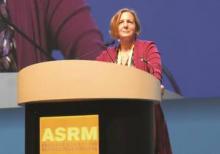User login
HONOLULU – Women with greater ovarian reserve had lower cardiovascular risk in a prospective study of 1,092 healthy, ovulating women aged 25-45 years, 250 of whom were followed for 3-5 years.
Measures of ovarian aging at baseline were inversely correlated with measures of systemic cellular aging. At the follow-up assessment, women who’d had lower ovarian reserve at baseline were more likely to have higher Framingham Heart Study assessment scores predicting increased risk for cardiovascular events.
“The ovary may be particularly sensitive to cellular aging” and could provide a relatively simple, objective way to identify long-term cardiovascular risk earlier in some women, Dr. Marcelle I. Cedars said at the annual meeting of the American Society for Reproductive Medicine.
She and her associates tested the women for anti-Müllerian hormone levels (AMH) and antral follicle counts (AFC) as markers of ovarian reserve. They assessed cellular aging by examining telomere length and mitochondrial DNA copy numbers in circulating white blood cells as biomarkers of cellular senescence. Shorter telomere length has been associated with worse cardiovascular risk in previous studies, she noted. The current study also measured lipid levels, fasting glucose, insulin levels, body mass index, waist circumference, and blood pressure.
Women with higher AFC and AMH at baseline had healthier lipid profiles at follow-up 3-5 years later, reported Dr. Cedars, director of the division of reproductive endocrinology and of the Center for Reproductive Health at the University of California, San Francisco. The upper 10th percentile of AFC levels were associated with significantly longer telomeres and significantly lower numbers of mitochondrial DNA copies, compared with the lowest 10th percentile of AFC.
Women with higher AFC or AMH at baseline had significantly lower Framingham risk scores at follow-up, compared with women with low AFC or average AFC, she said. The Framingham scores at follow-up showed a 10-year risk of MI of 2.1% in women in the low AFC tertiles, 1.3% in women in middle AFC tertiles, and 1.1% in women in high AFC tertiles.
The difference in cardiovascular risk level was statistically significant between the high and low tertiles for AFC and between the middle and low tertiles for AFC. For AMH levels, the difference in cardiovascular risk was significant between high and low tertiles, between high and middle tertiles, and between middle and low tertiles.
The ovary’s sensitivity to oxidative stress and telomere shortening plus the need for functional mitochondrial DNA in the oocyte may underlie the process that makes ovarian age a potential window onto cardiovascular risk, the investigators hypothesized.
Previous studies have shown that women with cardiovascular disease tend to be diagnosed later and generally to have a worse prognosis, compared with men, Dr. Cedars said. Using ovarian “age” as a window onto cardiovascular risk might help close that gap, she suggested.
Dr. Cedars reported financial associations with Nora Therapeutics, Ferring Pharmaceuticals, and the founders of Telome Health, a company that measures telomere length.
On Twitter @sherryboschert
This study supports the systemic view of reproductive health in the context of one’s overall health. Ovarian aging is something that can be measured fairly easily and it could become a useful way to identify women at particular risk for cardiovascular disease. Because women are typically diagnosed later in the course of their cardiovascular disease and have a worse prognosis than men, new ways to earlier identify women at particular risk could help improve outcomes for them.
Dr. Rebecca Z. Sokol is president of the American Society for Reproductive Medicine. She gave these comments in a statement released by the society, which said that she has no financial disclosures.
This study supports the systemic view of reproductive health in the context of one’s overall health. Ovarian aging is something that can be measured fairly easily and it could become a useful way to identify women at particular risk for cardiovascular disease. Because women are typically diagnosed later in the course of their cardiovascular disease and have a worse prognosis than men, new ways to earlier identify women at particular risk could help improve outcomes for them.
Dr. Rebecca Z. Sokol is president of the American Society for Reproductive Medicine. She gave these comments in a statement released by the society, which said that she has no financial disclosures.
This study supports the systemic view of reproductive health in the context of one’s overall health. Ovarian aging is something that can be measured fairly easily and it could become a useful way to identify women at particular risk for cardiovascular disease. Because women are typically diagnosed later in the course of their cardiovascular disease and have a worse prognosis than men, new ways to earlier identify women at particular risk could help improve outcomes for them.
Dr. Rebecca Z. Sokol is president of the American Society for Reproductive Medicine. She gave these comments in a statement released by the society, which said that she has no financial disclosures.
HONOLULU – Women with greater ovarian reserve had lower cardiovascular risk in a prospective study of 1,092 healthy, ovulating women aged 25-45 years, 250 of whom were followed for 3-5 years.
Measures of ovarian aging at baseline were inversely correlated with measures of systemic cellular aging. At the follow-up assessment, women who’d had lower ovarian reserve at baseline were more likely to have higher Framingham Heart Study assessment scores predicting increased risk for cardiovascular events.
“The ovary may be particularly sensitive to cellular aging” and could provide a relatively simple, objective way to identify long-term cardiovascular risk earlier in some women, Dr. Marcelle I. Cedars said at the annual meeting of the American Society for Reproductive Medicine.
She and her associates tested the women for anti-Müllerian hormone levels (AMH) and antral follicle counts (AFC) as markers of ovarian reserve. They assessed cellular aging by examining telomere length and mitochondrial DNA copy numbers in circulating white blood cells as biomarkers of cellular senescence. Shorter telomere length has been associated with worse cardiovascular risk in previous studies, she noted. The current study also measured lipid levels, fasting glucose, insulin levels, body mass index, waist circumference, and blood pressure.
Women with higher AFC and AMH at baseline had healthier lipid profiles at follow-up 3-5 years later, reported Dr. Cedars, director of the division of reproductive endocrinology and of the Center for Reproductive Health at the University of California, San Francisco. The upper 10th percentile of AFC levels were associated with significantly longer telomeres and significantly lower numbers of mitochondrial DNA copies, compared with the lowest 10th percentile of AFC.
Women with higher AFC or AMH at baseline had significantly lower Framingham risk scores at follow-up, compared with women with low AFC or average AFC, she said. The Framingham scores at follow-up showed a 10-year risk of MI of 2.1% in women in the low AFC tertiles, 1.3% in women in middle AFC tertiles, and 1.1% in women in high AFC tertiles.
The difference in cardiovascular risk level was statistically significant between the high and low tertiles for AFC and between the middle and low tertiles for AFC. For AMH levels, the difference in cardiovascular risk was significant between high and low tertiles, between high and middle tertiles, and between middle and low tertiles.
The ovary’s sensitivity to oxidative stress and telomere shortening plus the need for functional mitochondrial DNA in the oocyte may underlie the process that makes ovarian age a potential window onto cardiovascular risk, the investigators hypothesized.
Previous studies have shown that women with cardiovascular disease tend to be diagnosed later and generally to have a worse prognosis, compared with men, Dr. Cedars said. Using ovarian “age” as a window onto cardiovascular risk might help close that gap, she suggested.
Dr. Cedars reported financial associations with Nora Therapeutics, Ferring Pharmaceuticals, and the founders of Telome Health, a company that measures telomere length.
On Twitter @sherryboschert
HONOLULU – Women with greater ovarian reserve had lower cardiovascular risk in a prospective study of 1,092 healthy, ovulating women aged 25-45 years, 250 of whom were followed for 3-5 years.
Measures of ovarian aging at baseline were inversely correlated with measures of systemic cellular aging. At the follow-up assessment, women who’d had lower ovarian reserve at baseline were more likely to have higher Framingham Heart Study assessment scores predicting increased risk for cardiovascular events.
“The ovary may be particularly sensitive to cellular aging” and could provide a relatively simple, objective way to identify long-term cardiovascular risk earlier in some women, Dr. Marcelle I. Cedars said at the annual meeting of the American Society for Reproductive Medicine.
She and her associates tested the women for anti-Müllerian hormone levels (AMH) and antral follicle counts (AFC) as markers of ovarian reserve. They assessed cellular aging by examining telomere length and mitochondrial DNA copy numbers in circulating white blood cells as biomarkers of cellular senescence. Shorter telomere length has been associated with worse cardiovascular risk in previous studies, she noted. The current study also measured lipid levels, fasting glucose, insulin levels, body mass index, waist circumference, and blood pressure.
Women with higher AFC and AMH at baseline had healthier lipid profiles at follow-up 3-5 years later, reported Dr. Cedars, director of the division of reproductive endocrinology and of the Center for Reproductive Health at the University of California, San Francisco. The upper 10th percentile of AFC levels were associated with significantly longer telomeres and significantly lower numbers of mitochondrial DNA copies, compared with the lowest 10th percentile of AFC.
Women with higher AFC or AMH at baseline had significantly lower Framingham risk scores at follow-up, compared with women with low AFC or average AFC, she said. The Framingham scores at follow-up showed a 10-year risk of MI of 2.1% in women in the low AFC tertiles, 1.3% in women in middle AFC tertiles, and 1.1% in women in high AFC tertiles.
The difference in cardiovascular risk level was statistically significant between the high and low tertiles for AFC and between the middle and low tertiles for AFC. For AMH levels, the difference in cardiovascular risk was significant between high and low tertiles, between high and middle tertiles, and between middle and low tertiles.
The ovary’s sensitivity to oxidative stress and telomere shortening plus the need for functional mitochondrial DNA in the oocyte may underlie the process that makes ovarian age a potential window onto cardiovascular risk, the investigators hypothesized.
Previous studies have shown that women with cardiovascular disease tend to be diagnosed later and generally to have a worse prognosis, compared with men, Dr. Cedars said. Using ovarian “age” as a window onto cardiovascular risk might help close that gap, she suggested.
Dr. Cedars reported financial associations with Nora Therapeutics, Ferring Pharmaceuticals, and the founders of Telome Health, a company that measures telomere length.
On Twitter @sherryboschert
AT THE ASRM ANNUAL MEETING
Key clinical point: “Older” ovaries were associated with increased cardiovascular risk.
Major finding: The 10-year risk of MI was 2.1% in women in the lowest tertiles of AFC, 1.3% in middle tertiles, and 1.1% in high tertiles.
Data source: Prospective measures of ovarian reserve in 1,092 healthy women and cardiovascular risk assessments on 250 at 3-5 years.
Disclosures: Dr. Cedars reported financial associations with Nora Therapeutics, Ferring Pharmaceuticals, and the founders of Telome Health, a company that measures telomere length.

